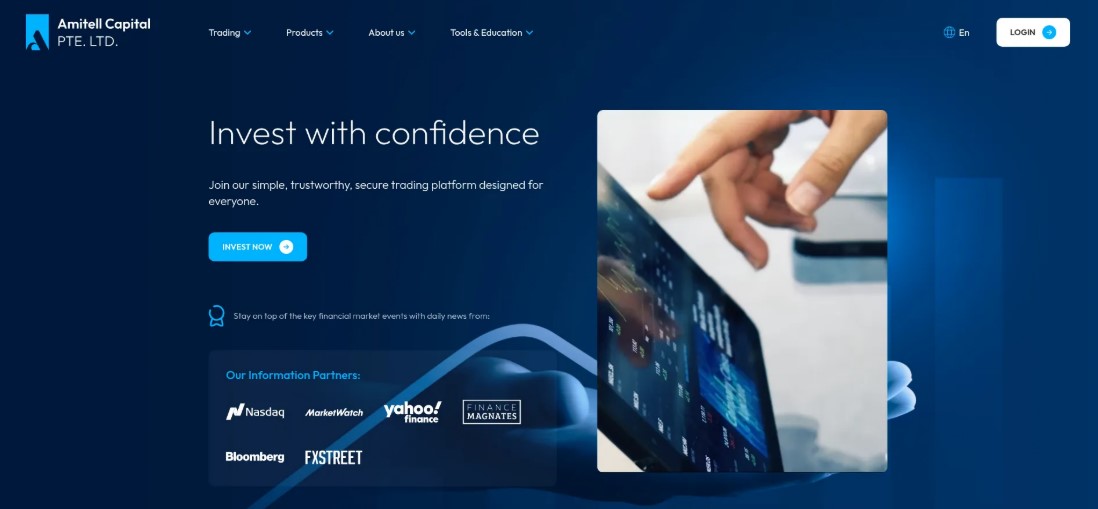AmitellCapLtd.com Scam Review -A Deception Unfold
AmitellCapLtd.com presents itself with the polish and promises of a modern wealth or trading service, but the platform exhibits a cluster of structural and behavioral signals commonly associated with high-risk or deceptive operations. Opaque ownership, limited verifiable credentials, marketing that emphasizes fast gains and VIP upgrades, and patterns that tend to produce deposit/withdrawal asymmetry together create a profile that calls for strong caution.
Opening — the referral that sounded solid, until it didn’t
Imagine a friend who usually knows a lot about investing sends you a quick message: “Try this platform — Amitell Cap. They match you with advisors and claim institutional access.” You click, create an account, and—just like that—you’re talking to an assigned advisor who seems knowledgeable. Small deposits go through smoothly and, for a time, the dashboard shows steady gains. Encouraged, you top up.
A few days later you request a withdrawal and the tone changes: new verification steps, a surprise processing charge, or a vague promise that the funds will be released “once cleared.” The friendly advisor is suddenly harder to reach. That arc—smooth welcome, friction at withdrawal—is a recurring pattern in problematic platforms. This review explains why AmitellCapLtd.com fits aspects of that pattern and what practical signals underlie the concern.
1) First impressions: professional sheen vs missing provenance
AmitellCapLtd.com uses high-quality visuals, confident fintech language, and standard trust signals (team photos, testimonials, account tiers). Those are effective conversion tools. But appearance alone is not evidence of legitimacy.
Key provenance items that should be obvious on a legitimate financial platform include:
-
A clear legal entity name and company registration number.
-
A verifiable corporate address and contact channels.
-
Named executives or compliance officers with traceable professional backgrounds.
-
Transparent disclosure of licensing and the regulator that oversees the service.
When polished presentation is not matched by clear provenance, the site is essentially asking users to trust on the basis of marketing rather than verifiable facts—an approach that increases risk materially.
2) Ownership transparency — who’s accountable?
Accountability begins with being able to identify the legal person or entity behind the product. For AmitellCapLtd.com, the red flags often observed in similar cases include:
-
Lack of detailed corporate filings or registration numbers displayed prominently.
-
Domain registrant information that is masked behind privacy services.
-
Contact addresses that point to virtual offices or are vague rather than a verifiable headquarters.
When ownership is effectively anonymous, the practical problem is not merely informational: it makes dispute resolution, legal recourse, or regulator inquiries much harder. Entities that wish to be trusted typically make that trust easy to verify; those that obscure ownership make accountability difficult.
3) Regulation & licensing — the missing safety net
Legitimate brokers, fund managers, and financial advisers provide verifiable regulatory information because regulation creates enforceable minimum standards: client fund protections, audits, and complaints processes. A credible firm highlights licence numbers and the regulator’s jurisdiction so anyone can check those claims independently.
If AmitellCapLtd.com lacks clear, confirmable regulatory credentials, that absence is not a technicality. It means user protections that normally apply under regulation—for example, segregated client accounts, mandatory reporting, and dispute resolution—are not demonstrably in place. From a risk perspective, that gap increases the potential for arbitrary changes in terms, difficulty recovering funds, or opaque fund handling.
4) The technology & “smart strategy” pitch — marketing vs evidence
AmitellCapLtd.com may lean on modern buzzwords—AI allocations, institutional algorithms, or proprietary strategies—to imply an edge. Those claims are attractive, but persuasive language must be paired with verifiable proof:
-
Do they publish audited performance reports or third-party attestations?
-
Can trade logs be exported and reconciled with banking or exchange receipts?
-
Are risk metrics (drawdowns, volatility, slippage) disclosed and explained?
Absent such documentation, technical claims function as marketing. Promises of steady or high returns without auditability should be treated skeptically.
5) Onboarding & sales behavior — how quickly they move money
A common operational pattern for risky platforms looks like this: rapid onboarding, friendly outreach, small initial wins shown in dashboards, then pressure to deposit larger sums via account upgrades or VIP tiers.
Watch for these behaviors:
-
Immediate assignment of a personal manager after signing up.
-
Frequent outreach encouraging deposit increases.
-
Time-limited offers or “exclusive” spaces that create urgency.
-
Emphasis on increasing capital rather than on testing withdrawal mechanics.
These techniques prioritize accelerating deposits. When combined with unclear ownership and missing regulation, they’re classic risk multipliers.
6) Deposit vs withdrawal asymmetry — the operational litmus test
A practical test you can use with any platform is to compare how it treats money going in versus money coming out. Many problematic sites display the same asymmetry:
-
Deposits are processed quickly through multiple payment methods.
-
Early small withdrawals (token amounts) might be allowed to build confidence.
-
Larger withdrawals trigger additional documents, sudden “processing” fees, or indefinite delays.
If AmitellCapLtd.com permits easy deposits but introduces hurdles at withdrawal, that asymmetry signals a system optimized to retain capital rather than return it reliably.
7) Testimonials, dashboards and simulated proof — curate, don’t trust
On-site testimonials and internal dashboards are persuasive, but they are not independent verification. Use these checks to separate persuasive content from evidence:
-
Are testimonials traceable to real users outside the site?
-
Do charts come with exportable trade data or third-party audit confirmations?
-
Are performance claims accompanied by detailed risk disclosure and historic drawdowns?
When proof is confined to the platform itself, treat it as curated marketing rather than as reliable confirmation that funds are held or trades are executed as claimed.
8) Technical & domain indicators
Several technical signals add useful context:
-
Newly registered domain or frequent domain changes suggest short track record or rebranding risk.
-
WHOIS privacy masking obscures the registrant.
-
Hosting overlap with other short-lived financial sites implies a template approach.
-
Low organic traffic and minimal independent reviews reduce the chance of community oversight.
Each signal alone is not determinative, but together they change the odds and increase operational uncertainty.
9) Terms & conditions — what the small print often hides
Read the small print. Problem platforms often include contractual language that gives the operator broad unilateral authority:
-
Clauses that allow freezing or reallocating funds.
-
Vague “processing” fees that can be introduced later.
-
Bonus terms that lock up funds behind unrealistic trading volume thresholds.
-
Dispute resolution clauses tied to distant, complex jurisdictions.
If AmitellCapLtd.com’s terms grant the operator sweeping discretion over funds or dispute handling, that legal structure can be used to justify denials or delays at the moment clients request payouts.
10) Quick red-flag checklist
Use this at a glance:
-
Is the legal entity and registration number clearly published and verifiable?
-
Can you confirm a licence with a recognised financial regulator?
-
Are partner custodians, auditors, or trustees named and independently verifiable?
-
Are performance claims backed by exportable trade logs or third-party audits?
-
Do withdrawals process reliably without surprise fees?
-
Do account managers pressure you to deposit more before you test withdrawals?
-
Is domain ownership masked in WHOIS records?
-
Are testimonials corroborated on independent platforms?
Multiple negative answers here imply elevated risk.
Analytical conclusion
AmitellCapLtd.com combines a persuasive marketing front with structural omissions that materially increase risk: obscured ownership, absent verifiable regulation, upsell-focused sales tactics, and potential deposit/withdrawal asymmetry. These are exactly the kinds of features that, in many prior cases, preceded substantial user frustration and financial loss.
This review is a practical risk assessment, not a legal finding. For people prioritizing capital preservation and clear accountability, the platform lacks the core transparency and verification one would expect from a trustworthy financial service. Proceeding without independent verification of licences, custodianship, and withdrawal mechanics significantly raises exposure.
Report AmitellCapLtd.com Scam and Recover Your Funds
If you have lost money to AmitellCapLtd.com Scam, it’s important to take action immediately. Report the scam to Jayen-consulting.com, a trusted platform that assists victims in recovering their stolen funds. The sooner you act, the better your chances of reclaiming your money and holding these fraudsters accountable.
Scam brokers like AmitellCapLtd.com continue to target unsuspecting investors. Stay informed, avoid unregulated platforms, and report scams to protect yourself and others from financial fraud.
Stay smart. Stay safe.






